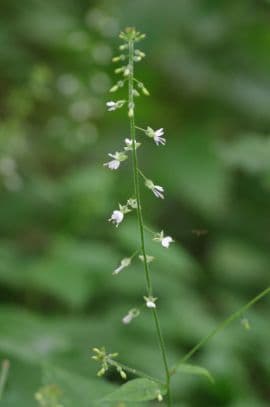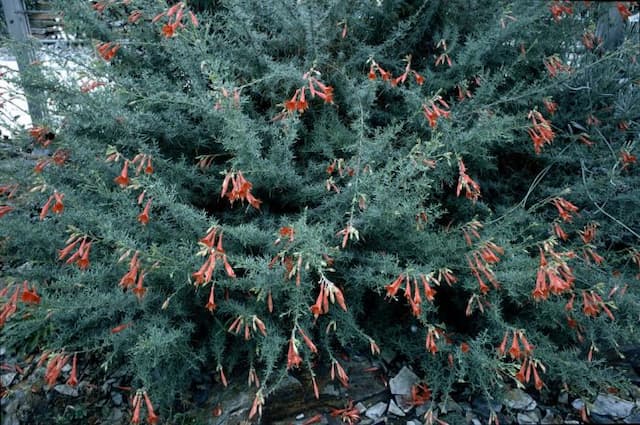Fuchsia Fuchsia 'Harry Gray' (d)

ABOUT
Fuchsia 'Harry Gray' is recognized for its attractive and distinctive flowers that dangle elegantly from the plant. The blooms have a dual-tone appearance, with the outer parts typically showing off a delicate shade that can range from pale pink to a soft purple. They create a striking contrast with the inner petals, which are a rich, deep purple, creating a layered appearance reminiscent of a ballerina's tutu. Each tubular flower hangs gracefully, often likened to an earring, with the petals flaring outwards at the bottom. The leaves of 'Harry Gray' are a vibrant green, adding to the plant's lush look, and can sometimes have a slight sheen that catches the light. Depending on the light and growing conditions, the foliage may also exhibit a touch of red or bronze along the edges or veins, providing additional visual interest beyond the stunning flowers. The stems and branches arch and may cascade, giving the plant an elegant, flowing form that makes it popular for hanging baskets and containers where the full beauty of the trailing blooms can be displayed.
About this plant
 Names
NamesFamily
Onagraceae
Synonyms
Harry Gray Fuchsia, Harry Gray Lady's Eardrops
Common names
Fuchsia 'Harry Gray'.
 Toxicity
ToxicityTo humans
The Fuchsia plant is generally considered non-toxic to humans. Ingesting parts of most Fuchsia species including flowers, berries, and leaves typically does not lead to poisoning or serious adverse health effects. As with many plants, individual sensitivity can vary and ingesting plant material may cause mild gastrointestinal discomfort in some people.
To pets
Fuchsia is also generally considered non-toxic to pets such as dogs and cats. If your pet ingests parts of a Fuchsia plant, they are unlikely to experience poisoning. However, as with humans, individual pets may have varying sensitivities and ingesting plant material may result in mild gastrointestinal upset. If you suspect your pet has consumed a large amount of the plant and is showing adverse symptoms, consult your veterinarian.
 Characteristics
CharacteristicsLife cycle
Perennials
Foliage type
Deciduous
Color of leaves
Green
Flower color
Mixed
Height
1-2 feet (30-60 cm)
Spread
1-2 feet (30-60 cm)
Plant type
Shrub
Hardiness zones
9
Native area
Central and South America
Benefits
 General Benefits
General Benefits- Attractive Blooms: Fuchsia 'Harry Gray' is known for its eye-catching pendant flowers, which add vibrant color and visual interest to gardens and outdoor spaces.
- Hummingbird Magnet: The plant is a popular choice among gardeners looking to attract hummingbirds, as these birds are drawn to the tubular flowers for nectar.
- Versatile Planting Options: It can be grown in garden beds, borders, and containers, making it suitable for various landscape designs and space limitations.
- Long Flowering Period: This variety often has a lengthy blooming season, providing consistent beauty and color from spring to fall.
- Shade Tolerance: Fuchsia 'Harry Gray' can flourish in partial shade, offering a stunning flowering option for areas of the garden that don't receive full sunlight.
- Easy Propagation: Fuchsia plants can be easily propagated from cuttings, allowing gardeners to multiply their plants and share with others without additional cost.
 Medical Properties
Medical PropertiesThis plant is not used for medical purposes.
 Air-purifying Qualities
Air-purifying QualitiesThis plant is not specifically known for air purifying qualities.
 Other Uses
Other Uses- Fuchsia 'Harry Gray' can serve as a natural dye source for fabrics; the flowers and berries can produce a range of colors from pinks to purples.
- As an educational tool in botany and horticulture, Fuchsia 'Harry Gray' provides a live example for the study of plant structure and growth habits.
- The plant can be used in artistic endeavors, such as flower arranging and botanical illustration, to create visually stunning compositions.
- Insect attractant in gardens, Fuchsia 'Harry Gray' flowers can entice beneficial pollinators such as bees, butterflies, and hummingbirds.
- Culinary decoration, where the nontoxic flowers can be used to garnish salads, desserts, and drinks for an exotic touch.
- Fuchsias, including 'Harry Gray', are often used in symbolism and can be gifted to convey conveyance of elegance and good taste.
- As a natural crafting material, dried Fuchsia flowers are used in making potpourri, giving it a colorful and decorative element.
- During festive seasons, live or potted Fuchsia plants can serve as eco-friendly, living decorations for indoor and outdoor spaces.
- Photography subjects due to their unique and vivid appearance, making them perfect for macro and nature photography.
- As a natural pest repellent, the presence of Fuchsia 'Harry Gray' in the garden can help deter certain types of insects.
Interesting Facts
 Feng Shui
Feng ShuiThe Fuchsia is not used in Feng Shui practice.
 Zodiac Sign Compitability
Zodiac Sign CompitabilityThe Fuchsia is not used in astrology practice.
 Plant Symbolism
Plant Symbolism- Elegance: The Fuchsia 'Harry Gray' is known for its elegant and graceful hanging blooms, symbolizing poise and refinement.
- Good Taste: The beautiful, vivid flowers of the Fuchsia plant indicate appreciation for beauty and sophistication, denoting good taste.
- Confiding Love: Fuchsia flowers are often associated with confiding love, representing a trusted and intimate emotional connection.
- Amiability: The friendly appearance of the Fuchsia blooms makes the plant often related to warmth and amiability.
 Water
WaterFuchsia 'Harry Gray', commonly known as Fuchsia, requires consistent moisture and should be watered when the top inch of soil feels dry to the touch. This typically means watering at least once or twice a week, but frequency depends on environmental conditions such as temperature and humidity. Provide water at the base of the plant, avoiding wetting the foliage, with about half a gallon for smaller plants and up to 1-2 gallons for larger, established plants every week during the growing season. In winter, reduce watering but do not let the plant completely dry out.
 Light
LightFuchsia 'Harry Gray' prefers bright, indirect light with protection from intense afternoon sun. The ideal spot would be a location that receives morning sunlight and dappled shade in the afternoon, such as an east-facing window or a covered patio. Avoid deep shade as it may result in reduced flowering and poor growth.
 Temperature
TemperatureFuchsias prefer a cooler climate with temperatures ranging between 60°F and 75°F during the day and cooler nights. They can survive temporarily in temperatures as low as 40°F, but are not frost-tolerant and cannot tolerate temperatures below freezing. The ideal temperature range for optimal growth is between 55°F and 70°F.
 Pruning
PruningPruning Fuchsias encourages bushier growth and more blooms. Prune in late winter or early spring before new growth begins. Remove any dead or weak stems and cut back approximately one-third of the plant selectively to shape it and promote vigorous growth. Additionally, throughout the growing season, pinch off the tips of branches to encourage branching and remove spent flowers to promote continuous blooming.
 Cleaning
CleaningAs needed
 Soil
SoilThe best soil mix for Fuchsia, commonly known as Lady's Eardrops, should be well-draining and fertile, with a pH between 6 and 7. A mix of loam, peat moss, and sand or perlite in equal parts is ideal, ensuring that the plant has a balance of moisture and air circulation.
 Repotting
RepottingLady's Eardrops should generally be repotted every year or two, preferably in the spring. If the plant has outgrown its current pot or the soil is exhausted, repotting is necessary to provide fresh soil and encourage continued growth.
 Humidity & Misting
Humidity & MistingLady's Eardrops thrive best in high humidity conditions, with ideal levels ranging from 60% to 70%. They benefit from a humid environment, which can be achieved through regular misting or by placing the plant on a pebble tray with water.
 Suitable locations
Suitable locationsIndoor
Bright, indirect light and consistent moisture for Lady's Eardrops.
Outdoor
Partial shade, shelter from wind, and moist soil for Lady's Eardrops.
Hardiness zone
10-11 USDA
 Life cycle
Life cycleThe Fuchsia 'Harry Gray' begins its life cycle with seed germination, where seeds planted in fertile, well-drained soil start to sprout when temperatures are warm and consistent, usually in the spring. Following germination, the seedlings grow into juvenile plants, developing distinctive foliage and a root system. As the plant matures, it enters the vegetative stage, producing vigorous stem and leaf growth, preparing the plant for flowering. The flowering stage occurs during the summer months when the plant displays its striking hanging blooms that are attractive to pollinators. After pollination, if it occurs, the plant may produce tiny fruits that contain seeds, allowing for the potential dispersal and continuation of the species; however, many cultivars are propagated vegetatively. As temperatures cool and daylight lessens, the Fuchsia 'Harry Gray' enters into a dormant period during winter, with reduced growth until the cycle begins anew in the spring.
 Propogation
PropogationPropogation time
Spring-Early Summer
The Fuchsia 'Harry Gray', more commonly known as hardy fuchsia, is typically propagated by cuttings. Softwood cuttings are the favored method, usually taken in late spring or early summer when the plant is actively growing. A cutting should be about 2 to 4 inches long (5 to 10 cm) with a few leaves left on the top. It's important to select a healthy piece of the plant and cut just below a leaf joint or node. The bottom end is then dipped in rooting hormone powder to encourage root development and planted in a mix of half peat and half perlite or sand to provide good drainage. The cutting should be kept moist and in a warm place out of direct sunlight. Roots typically develop within a few weeks, after which the young plants can be transferred to individual pots to continue growing.









